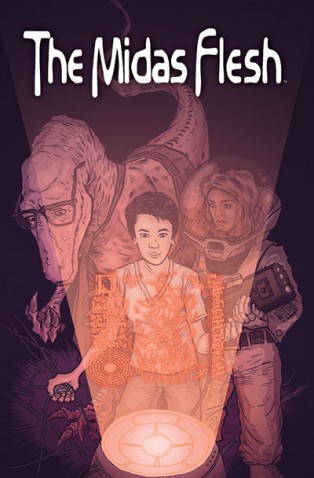
The Midas Flesh #1 of 8
Written by Ryan North
Art by Shelli Paroline, Braden Lamb
Covers By John Keogh, Emily Patridge, Noelle Stevenson
Published by Boom! Studios
If prodded or enticed or just listened too, children will tell stories. These stories often combine disparate elements: dinosaurs, war, robots, fighting, other stories, and they usually end with the adult or the young story teller losing interest. Looked at from a distance, or analyzed for a deeper meaning, thesestories fall apart as childish whimsy. At first blush, The Midas Flesh seems like one of those stories, relying on its absurdities to keep it together and hoping no one notices. Instead, the first issue sets up an intriguing science fiction premise then another, successfully combining them into adventurous whimsy without sacrificing the stakes.
From its premise to its art, The Midas Flesh takes after Osamu Tezuka (Astro Boy, Ode to Kirihito) in the best way. What begins as a rip-roaring space adventure, complete with a Utahraptor doing science in a space suit, ratchets into a mystical intergalactic story with hints of philosophy and ancient Greek myths. The story quickly flashes back, way back. It begins with the First Miracle, the lighting strike that made life on earth possible, and more or less ends with the Second Miracle, when King Midas gets his eponymous touch. Instead of turning everything he touches to gold, the chain reaction leads to a luxurious but dead planet. This Midas’ Touch works more like an infection. The last panel forebodes could just go intergalactic with our heroes, including that Utahraptor, being the first victims of a gold, dead universe.

The dialog between the crew is dense with exposition, an unfortunate choice, especially since the goals of the crew are neatly laid out. The notion of vague but appropriately roll-defining orders comes to mind ( ‘Punch it, Chewie!’), but that sort of aggression might feel out of place. The Midas story dialog is pretty great though, reaching a non-aggressive bro tenor that just fits a mostly peaceful city state. Midas’ character is so laid-back he decides make hard boiled eggs for a drunk, the inciting incident to his story. This notion that all the characters are more or less good guys definitely makes the scenes less tense, but it definitely reinforces the tone. The stakes are astronomically high, but that’s no reason these characters shouldn’t be down-to-earth.

Like Tezuka’s work, it’s the simplicity of the characters that allows for such a broad range of to be connected without ever seeming to reach. The art is clean and fun. There’s a feeling in comics that characters must reflect their antagonist or threat in their own design. Hulk is big enough to smash anything (so anything shall be smashed), leaving little room for tension with the character himself. By crafting simple characters and immediately ‘killing’ off the kings among them, The Midas Flesh sets the stage for something rarely seen in comic books: a real adventure with real stakes and the possibility of serious fun, the kinds kids get to have.

